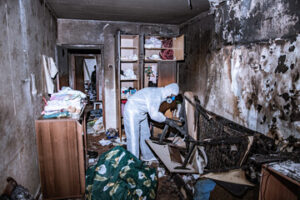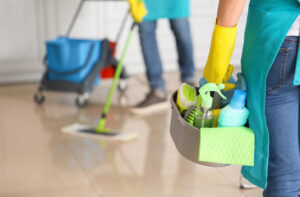All Pro Services specializes in restoring damaged property after natural calamities like floods, fires, and earthquakes. The goal is to return the building to its pre-disaster condition while ensuring safety for the occupants.

Performing this job in hazardous environments requires proper PPE, such as DuPont Tyvek coveralls, which block airborne particles and keep the wearer dry and comfortable. Tools, such as containment poles, are also important, making blocking off contaminated areas easy.
Natural disasters can cause water damage that can devastate home and business owners. Flooding, hurricanes, mudslides, and earthquakes can cause structural damage and water leaks. When a disaster occurs, it’s critical to have primary damage control, estimates, and cleanup done quickly and professionally. Disaster restoration services will ensure that all affected areas are dry and cleaned thoroughly to prevent further damage, mold, and odor.
Disaster cleanup requires extensive work in an environment that can be unsanitary, dangerous, and even unstable. Workers face exposure to hazardous conditions such as contaminated floodwater, mold, shattered building materials, and debris. It’s important that all workers involved in disaster cleaning are aware of these risks and take necessary safety precautions.
Professional disaster cleaners will drain, pump, and clean the water. Sitting water breeds bacteria, so it must be removed immediately. Professionals will inspect the foundation for further issues once the area is dry and decontaminated.
The loss of natural ‘buffers’ like trees, river bank-side vegetation, and coastal mangroves can contribute to flooding during disasters. Rapid urbanization also increases the risk by rapidly channeling run-off into storm drains.
After a disaster, it’s critical to drain and overturn all containers that contain standing water, such as rain gutters, buckets, vases, and more. This can help reduce mosquito breeding and prevent the spread of insect-borne diseases.
The sewage system may be affected after a disaster, resulting in a backup of toxic waste. Sewage is a biohazard that must be treated with extreme care. Disaster cleaning professionals will clean up and dispose of any accumulated sewage. They will also prevent future sewage backups by repairing damaged plumbing and taking preventive measures. For example, they may board open holes and broken windows to offer temporary security and protection for the property until further repairs can be made. Throughout this process, the team will inspect for mold and odor and perform remediation.
If you’ve been through a natural disaster, you know that cleanup is a major undertaking. Whether you rode out the storm at home or evacuated to safety, returning to your damaged house can be a devastating experience. However, with some help from a professional disaster restoration company, you can start to restore and rebuild.
When a disaster occurs, homeowners, insurance companies, and businesses want a team of professionals who can respond quickly, provide accurate estimates, and complete the work promptly and efficiently. This includes completing the primary damage control, cleaning the property, and restoring the affected areas to pre-disaster conditions.
Depending on the nature of the disaster, there may be additional concerns like flooding, debris removal, mold, fire and smoke damage, chemical spills, and more. These issues require specialized cleaning techniques that only qualified professionals can handle.
Fire damage is often worse than water damage, as it can leave a property in disrepair with no resemblance to the original condition. When a fire breaks out, there is also the risk of smoke inhalation, which can be deadly. Even after the fire has been put out, there is still lingering soot that can be extremely difficult to remove.
In addition to causing structural damage, fire can ruin electronic devices and other equipment. It can also contaminate materials and cause odors that are difficult to eliminate. This is why it’s important to use the services of a disaster cleanup company with a team of trained and experienced technicians to ensure your property is completely restored.
Disasters can be unpredictable, but preparing for them is essential. Knowing what to expect will help you plan and stay safe during cleanup. Whether you’re dealing with floods, wildfires, smoke, mudslides, or other natural disasters, these tips will help you prepare for any situation.
Sewage backup is one of the worst disasters homeowners have to face. This is because sewage contains dangerous bacteria, viruses, and other contaminants that are very unhealthy for humans to come into direct contact with. This is why you should always try to clean up sewage with others. Instead, enlist the help of professional restoration companies trained to handle this type of work.
When the sewer line becomes clogged, blocked, or overflows, wastewater and sewage can be forced back through all drains in your home, including toilets and sinks. This can cause a wide range of damage to your property and belongings, including extensive mold growth and severe water damage. The best way to prevent a sewage backup is to keep everything that goes down your drains away from the sewer line, like oil, food scraps, and diapers. If you see sewage pooling around your gutters, you should call a plumber immediately.
Your sewer line is responsible for taking all the wastewater from your home and directing it to your septic tank or public city connection. However, this line can become clogged or overflow for many reasons, such as tree roots, heavy rainstorms, or just small blockages in your drain pipes.
It would be best to watch for any signs of a sewage backup, such as a bad smell in your house or visible sewage stains on the ground. You should also only use your home’s tubs, showers, and sinks once you get the problem fixed by a plumber. You should also notify your municipality and check your insurance policy to know if it covers sewage disasters.
Sewage cleanup is a messy job that requires special tools and safety equipment such as masks, protective gloves, and goggles. You should also turn off the electricity in the area to prevent electrocution and short circuits. Lastly, you should remove any soaked sewage items and dispose of them. This may include carpets, furniture, drywall, wooden framing, and other materials.
When a window breaks, it can create a huge mess. The first step is to block off the area as much as possible. If you have kids or pets, ask them to leave the room and avoid the broken glass. If a storm is raging, it can also be dangerous to be near the window if cracks or pieces of broken glass could fall.
It is best to call a professional to handle broken windows caused by the elements, but you can clean up the mess while you wait. Before starting:
- Ensure you have safety gear, including closed-toe shoes and thick gloves.
- Start by carefully sweeping and vacuuming the floor around the window.
- Remove any larger pieces and put them in a garbage bag or cardboard box for safe disposal.
Afterward, you can use pieces of tape to go over the floor again, picking up microscopic shards that may have found their way into your feet and hands. Then, you can cover the window with plywood or a heavy tarp for security and warmth. Many police departments employ the Broken Windows theory, developed by criminologist George Kelling in 1982, as a policing strategy.
